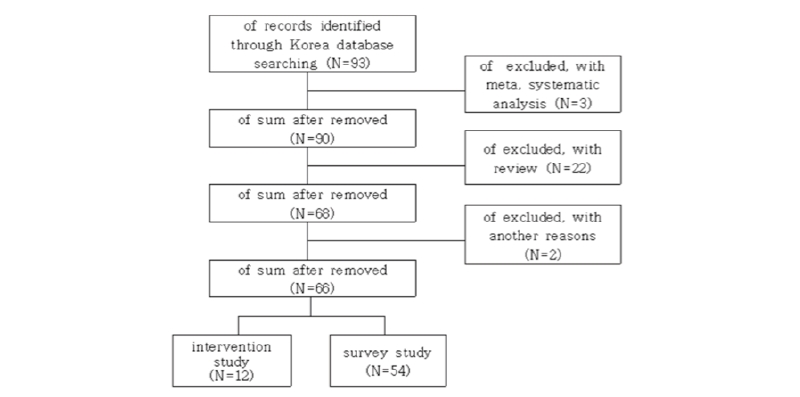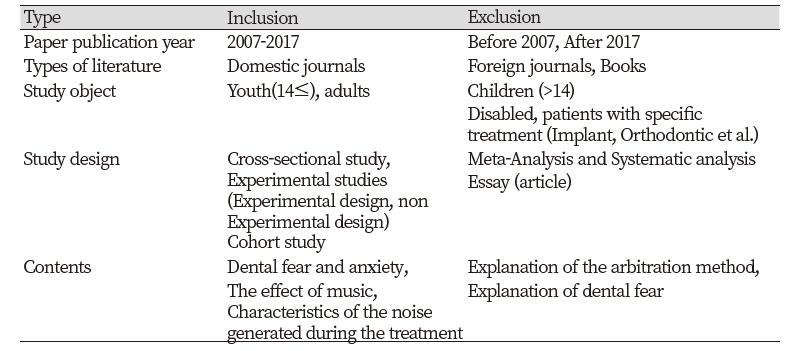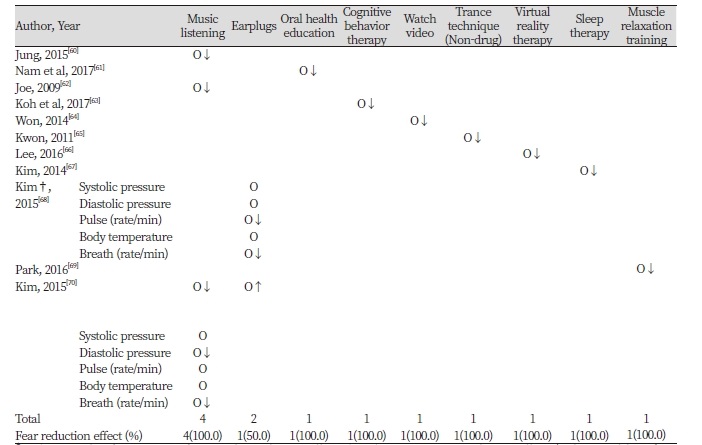서론
치아를 상실하게 되는 주된 원인은 치아우식증과 치주질환으로 이러한 구강병을 예방하기 위해서는 정기적인 구강검진이 매우 중요하다[1]. 2015년 실시된 아동구강건강실태조사[2]에 따르면 최근 주요 OECD 국가들에서의 치아우식증은 계속 감소하고 있으나 그에 비해 우리나라의 치아우식증 발생률은 좀처럼 줄어들지 않고 있다. 또한 국민건강영양조사에 의한 치주질환 유병률 역시 19세 이상 집단에서 2012년[3] 22.7%에서 2015년[4] 29.8%로 꾸준히 증가하고 있다. 이러한 추세에도 국민건강통계[5]에 따르면 최근 1년간 치과 정기검진을 받은 적이 있다고 응답한 19세 이상의 성인은 34.3%로 정기 검진의 중요성에 비해 실제 정기검진을 받은 경우는 낮았다. 이는 전체 국민의 절반정도가 치과치료에 대한 두려움 즉 치과치료에 대한 공포감 때문에 치과 방문을 기피하기 때문이라고 하였다[6].
공포증은 청소년기와 성인기에 약 절반이 발현되며 전체 성인의 약 16%가 치과 공포증가 있다고 하였다[7]. 청소년기의 치과공포증은 성인에까지 지속 될 수 있으며 이는 치과이용률을 감소와[8], 구강건강 악화 등의 문제를 야기 시킬 수 있다[9]. 이에 치과공포에 대한 이해와 해결방안 등의 연구는 매우 중요한 과제라 할 수 있을 것이다.
선행연구를 살펴보면, 치과공포감이 치과 의료서비스 이용에 미치는 영향에 대해 분석한 최 등[10]의 연구에 따르면 치과공포감이 지난 1년 동안 환자의 치과 의료서비스 이용을 결정하는데 가장 중요한 요인으로 나타났다. 치과치료에 대한 공포감은 단순히 환자가 느끼는 반응이라기보다 종합적으로 느끼는 긴장, 근심, 불안을 나타내며[11] 치과종사자나 치료 상황에 대한 명확하면서도 지속적인 것으로 공포의 한 범주로 보고 있다[12]. 또한 치과 치료에 대한 공포감이 높은 사람이 낮은 사람보다 치아우식증의 발생률이 더 높은 것으로 보고되었다[13]. 이에 치과공포에 대한 해소 방안 연구가 양대 구강병 예방과 구강건강 수준 향상에 기여하는 중요한 과제가 될 수 있을 것이다. 현재 치과 공포에 관한 연구로는 일부 청소년 및 성인의 치과 공포감 관련 요인[14-18], 치과치료공포감 및 치과의사 불신감과 치아우식증의 관련요인[19-22], 치과 내원 환자의 치과 치료 시 공포감에 관한 연구[23,24] 등이 주를 이루었으며 개인기질과 치과치료와 관련된 치과공포감[25-27]에 관한 연구들이 있었다. 이러한 연구들을 통해 치과 진료실에서 치과공포가 환자관리에 중요한 영향요인이며 더불어 치과진료를 방해 요인임을 알 수 있다. 따라서 치과공포를 가진 환자의 치과진료를 유도하기 위해서는 치과공포에 관한 요인을 분석하는 것과 더불어 환자의 특성을 파악하는 것이 중요한 과제라 할 수 있을 것이다. 이에 전[28]은 2004년부터 2012년까지의 치과공포 요인에 대한 18편의 단면연구를 통한 동향분석을 하였고, 본 연구에서는 청소년과 성인을 대상으로 치과공포와 불안 등에 대한 최근 10년간의 단면연구를 비롯한 코호트, 실험연구를 포함한 연구동향과 치과공포에 영향을 주는 요인 및 중재연구의 효과를 분석하여, 치과공포 예방 프로그램 개발 및 적용에 필요한 학문적 기반과 향후 연구방향을 제시할 수 있는 기초자료를 마련하고자 한다. 본 연구의 구체적인 목적은 다음과 같다.
1) 2007년~2017년간의 치과 공포와 불안 등에 대한 최신 연구동향을 분석한다.
2) 치과공포와 일반적인 특성과의 연관성과 중재연구들의 효과에 대해 분석한다.
3) 분석 논문들의 치과공포 측정을 위한 도구와 그에 대한 세부 항목들을 분석한다.
4) 향후 청소년과 성인을 대상으로 한 치과공포를 예방할 수 있는 프로그램 개발과 적용에 대한 기초자료로 제공한다.
연구방법
1. 문헌 검색 및 선정 기준
본 연구는 국내 14세 이상의 청소년 및 성인을 대상으로 한 치과공포와 관련된 연구를 대상으로 선정 및 수집하였다. 첫째, 논문 선정을 위해 국내전자데이터베이스인 학술연구정보서비스(RISS), DBPIA, 한국학술정보시스템(KISS), 국회전자도서관을 검색 하였다. 검색 색인은 ‘치과불안’, ‘치과공포’, ‘공포감’, ‘과거 치과경험’, ‘Dental fear’, ‘Dental phobia’를 적절히 조합하여 검색하였다. 둘째, 문헌은 최근 10년 동향을 보기 위해 출판 년도를 2007년부터 2017년까지로 제한하였으며, 일반적인 인식수준이 문화적 차이에 의해 다를 수 있는 국외거주자를 대상으로 한 국외학술지 및 국외서적은 배제하였다. 셋째, 연구 대상은 국내 거주하는 중학교 1학년 이상과 성인으로 제한하였다. 초등학생 이하의 어린이는 치과 공포에 영향을 미치는 혼란변수가 많을 것으로 사료되어 배제하였고, 임플란트나 교정치료 등 특정치료를 받는 환자 및 장애인을 대상으로 한 연구는 일반화하기 어려움이 있어 배제하였다. 마지막으로 연구 설계는 단면연구 및 중재연구로 제한하여 메타분석과 체계적 문헌고찰, 종설연구는 배제하였다. 그리고 연구 방법을 제시하거나 설명한 논문 등은 제외하고 연구 목적이 요인분석인 문헌과 치과 공포 감소에 유효한 논문을 선정하였다<Fig.1>. 그 결과, 검색된 93편의 문헌 중 중재연구 12편, 설문연구 54편으로 총 66편의 논문이 본 연구의 대상이 되었다<Table 1>.
연구결과
1. 치과공포 연구 현황
1) 논문 게재 현황
2007년부터 2017년까지 게재된 치과공포 관련 연구 수를 살펴본 결과, 설문연구는 매년 비슷한 정도의 논문이 발표되었으나 2010년과 2014년에 논문의 수가 크게 증가 하였다. 중재연구는 2007년부터 2013년까지 발표된 논문의 수가 총 3편이였으나, 2014년 이후 점차 증가하는 추세를 보였다<Fig. 2>.
2) 연구의 특성 현황
연구대상 논문의 표본 수는 설문연구의 경우 200~399가 29편(53.7%)으로 가장 많았고, 중재연구의 경우에는 ~199가 11편(91.7%)으로 가장 많았다. 연구대상 수집 장소는 설문연구의 경우 중·고등학교가 26편(48.1%), 치과 병·의원이 10편(18.5%) 순으로 많았으며, 중재연구의 경우는 치과 병·의원이 10편(83.3%)으로 많았고 나머지 2편은 대학교로 나타났다<Table 2>.
|
Table 2. Status of study characteristics and Intervention method ( N = 6 6 ) 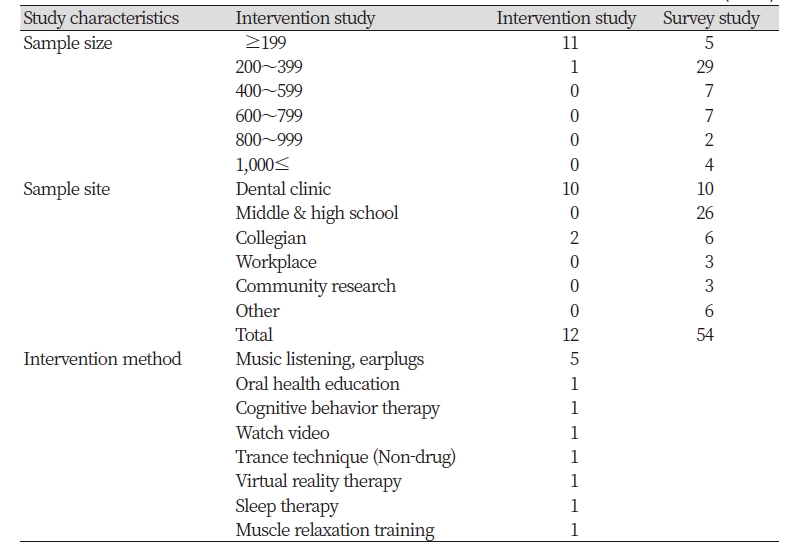
|
|
|
Controlled clinical trial |
|
3) 중재방법 현황
본 연구의 고찰 대상 논문에서 사용한 중재 방법의 연구 현황은 <Table 2>와 같다. 공포감을 감소시키기 위한 중재 방법으로는 음악 감상, 귀마개의 사용과 같이 소리를 이용한 방법이 5편으로 가장 많았으며, 인지행동요법, 비디오 시청, 트랜스기법에서는 2편, 구강건강교육, 비디오 시청, 수면요법, 가상현실을 이용한 방법 등에서는 모두 1편으로 나타났다.
2. 치과공포 측정도구 현황
연구대상 논문에서 치과공포 및 불안을 측정하는 데 이용한 도구는 <Table 3>과 같다. DFS와 DBS는 치과공포를 측정하는데 신뢰성과 타당성을 인정받는 주요 측정도구로 현재 널리 사용되고 있다. 중복 집계를 허용하여 본 설문연구에서는 DFS를 이용한 논문이 48편(63.2%), DBS를 이용한 논문이 7편(9.2%)으로 나타났고, 중재연구의 경우는 DFS를 사용한 논문이 4편(20%)으로 나타났다.
3. 치과공포 측정도구 세부항목
연구대상 논문에서 사용된 주요 측정도구의 세부항목을 중복집계를 포함하여 분석한 결과는 <Table 4>와 같다. 공포감에 가장 큰 영향을 주는 요인은 ‘주사바늘을 찌를 때’가 52.4%로 가장 높게 나타났으며 ‘치아를 깎는 느낌이 들 때’(11.9%), ‘드릴 소리를 들을 때’(9.5%) 순으로 나타났다.
4. 연구대상의 인구사회학적 변수
연구대상 논문에서 연구대상자의 인구사회학적 변수는 <Table 5>와 같다. 연구대상 논문에서 성별과 연령/학년은 대부분의 논문에서 변수로 포함하고 있었고, 주관적 구강건강인식, 월소득 수준 순으로 나타났다. 성별은 35편(83.3%), 연령 20편(55.6%)으로 유의하게 나타났으며 신뢰성은 치과의사에 대해서는 11편(84.6%), 치과위생사에 대해서는 4편(57.1%)으로 유의하게 나타났다. 그 외에 간접통증 경험, 직접통증 경험, 불충분한 마취 등의 순으로 공포에 영향을 주는 것으로 나타났다. 성별에서는 여성이 남성보다 치과관련 공포감을 더 많이 느끼는 것으로 나타났고, 연령/학년은 2편을 제외하고 연령이 높을수록 공포감을 느끼는 것으로 나타났다.
|
Table 5. Demographic variables of the study subjects 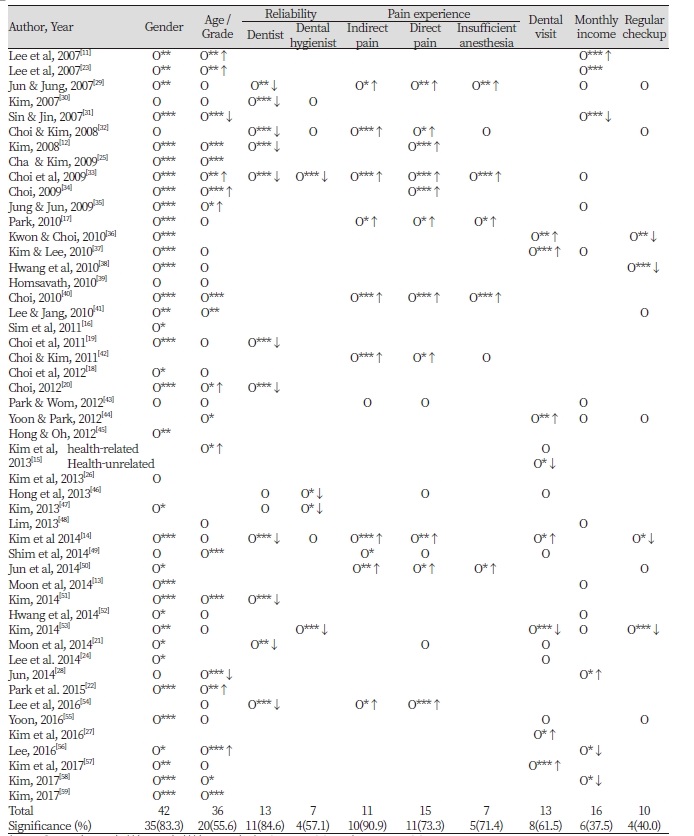
|
|
|
*:Significance(p<0.05), **(p<0.01), ***(p<0.001), ↓: decreased fear, ↑: increased fear |
|
5. 중재 연구의 효과
연구대상 논문에서 공포감 감소에 영향을 미치는 중재방법 효과는 <Table 6>과 같다. 중재방법으로 음악 감상을 사용한 4편의 연구논문 모두에서 감소효과가 있었으나, 귀마개를 사용한 경우에는 오히려 외부와의 소리를 차단하여 공포감이 증가하는 결과가 나왔다. 이러한 소리를 중재방법으로 사용한 연구를 제외한 비디오 시청, 트랜스기법, 수면요법, 근육이완 요법 등에선 모두 공포감 감소에 효과가 있는 것으로 나타났다.
총괄 및 고안
본 연구는 국내 청소년과 성인을 대상으로 실시 된 치과공포에 대한 연구문헌을 고찰하여, 치과공포와 불안에 대한 연구동향을 파악하고 향후 연구방향 제시를 위한 기초 자료로 제공하고자 한다.
2007년부터 2017년도까지 발표된 치과공포에 관련된 연도별 게재 현황을 살펴본 결과, 설문연구 2014년에 11편으로 제일 많았고 그 다음 2010년에 9편으로 많았으며 2015년에 1편으로 가장 적었다. 중재연구는 2014년 이후로 증가하는 추세를 보였다. 시간이 지날수록 치과공포증 환자에 대한 관심이 증가하고 있으며, 공포를 해소하기 위한 다양한 연구가 진행되고 있는 것으로 나타났다. 이는 치과공포증이 단순히 정신건강학적 문제뿐만 아니라 환자의 삶의 질에 많은 영향을 미칠 수 있는 심각한 문제라는 것에 대한 인식이 높아졌기 때문이라고 보고한 박[72]의 연구와 같이 설명할 수 있을 것이다.
본 연구의 문헌고찰에서 설문연구와 중재연구에서 가장 많이 사용된 공포 측정도구는 DFS로 나타났다. 최 등[32]의 연구에 따르면 Kleinknecht (1973)의 DFS 척도는 신뢰도와 타당도가 입증되었으며, 다양한 항목으로 문항이 구성되어 있기 때문에 치과공포의 원인을 폭넓게 평가할 수 있다고 하였다. 이에 따라 고찰된 문헌에서 DFS를 가장 많이 사용하였을 것으로 사료된다.
공포 측정 도구들의 세부항목 중 치과공포감에 가장 큰 영향을 미치는 것으로 ‘주사바늘을 찌를 때’가 높게 나타났으며 ‘치아를 깎는 느낌이 들 때’, ‘드릴 소리를 들을 때’ 순으로 주로 치료자극 요인과 관련하여 높게 나타났다. 우리 국민 대부분이 예방보다는 치료를 목적으로 치과 의료기관에 방문하고 있으며[29] 환자가 치료 과정에서 경험하는 치과 치료가 복합적으로 환자에게 작용하여 공포를 유발하기 때문이다[73]. 이에 치료 자극이 상대적으로 적은 예방 위주의 치료가 이루어지도록 노력해야 한다. 또한 치료를 시행하기 전 미리 치료 과정에 대한 설명을 진행하거나 치료 중간마다 설명을 하는 등 치과 종사자의 노력이 필요하며, 환자가 치료 시 불편함이나 공포를 느끼는 경우 손을 들어 표현할 수 있도록 해야 할 것이다. 이 외에도 환자의 치과 공포를 완화시키기 위해 음악감상, 귀마개, 교육, 수면요법 등 많은 연구들이 진행되었는데, 귀마개를 이용한 2개의 논문 중 김[68]의 연구에서는 치과 공포가 감소한 반면 김[70]에서는 증가했다. 이를 감각박탈이라는 이론을 근거로 설명하였는데 환자들이 구멍포 착용으로 시야까지 차단된 상태이며 익숙해진 청각 자극을 물리적으로 차단하는 것이 오히려 불안을 야기할 수 있다고 하였다. 이에 따라 치료 시 공포를 완화하기 위한 방법 중 환자에게 맞는 방법을 적용해야 할 것으로 사료된다.
치과공포에 영향을 미치는 일반적 특성 중 성별에서는 여성이 남성보다 높은 수준의 치과 공포와 불안을 보였으며, 이는 심리학적으로 여성이 남성에 비해 언어적 능력이 높고 정서적으로 민감도가 높은 점이 치과공포감에 반영되어 나타난 결과라고 하였던 최[34]의 연구결과와 유사하였다. 이러한 문제에 대한 공포를 완화시키기 위해 환자 맞춤형의 프로그램 및 다양한 상담 기법을 활용한 적극적인 상담을 제공해야 할 것이며, 치과 진료에 대한 환자의 공포와 불안을 완화할 수 있는 방안을 마련하고 이에 대한 교육이 이루어지도록 노력을 기울여야 할 것이다.
그 외에 환자들은 치과의사와 치과위생사에 대한 신뢰도가 낮을수록 공포감을 더 느꼈으며, 치과종사자에 대한 신뢰도가 낮을수록 공포감을 느낀다고 나타났던 김[30]의 연구와 유사한 결과였다. Folayan 등[74]은 치과경험은 두려움을 불러일으킬 수 있지만 치과의사의 태도와 노력에 의해 조절할 수 있다고 보고하였고, Abrahamsson 등[46]은 치과의사에 대한 신뢰수준과 치과공포의 중요성을 강조하며 환자의 공포를 낮출 수 있는 의사의 의사소통 능력이 중요하다고 하였다. 따라서 환자의 치과공포를 줄이기 위해 치과 공포감과 치과의료 종사자들의 신뢰성에 대한 지속적인 연구와 치과의료 종사자들의 상호간 의견교환이 필요할 것으로 사료되며, 또한 이러한 치과 치료에 대한 공포감은 치과의료종사들의 노력에 의해 어느 정도 조절이나 감소시키는 것이 가능할 것으로 사료된다.
본 연구는 문헌 검색용어의 범위가 한정적으로, 일부 연구의 내용이 본 연구와 일치하나 누락되었을 가능성이 있다. 또한 문헌고찰 된 연구의 분석방법 및 내용이 상이하며, 성인에 비해 청소년이 많고 편의 추출에 의해 연구가 진행되어 일반화하기에는 한계가 있다. 또한, 중재연구를 포함한 문헌의 표본이 적어 결과가 왜곡되어 나타날 가능성이 있다. 이러한 제한점에도 불구하고 국내 청소년 및 성인을 대상으로 한 치과공포 연구 및 중재연구를 수집하여 요인과 중재방법을 분석하고 정리하여 나타냈다는 점에서 의의가 있다고 사료된다. 또한 추후 후속연구는 검색용어의 범위와 조건을 확장하여 대상자를 전 연령층으로 확대하여 보고, 치과공포에 대한 국내문헌 뿐만 아니라 국외문헌을 비교한 구체적인 연구가 필요할 것이다.
결론
본 연구는 국내 청소년과 성인을 대상으로 치과공포와 불안 등에 대한 최신 연구동향을 살펴보고 중재연구들의 특성 및 치과공포 요인을 체계적으로 분석함으로써, 향후 연구방향을 제시하고 치과공포 예방 프로그램 개발 및 적용에 필요한 기초자료가 되고자 실시하였으며 다음과 같은 결과를 얻었다.
1. 표본의 수는 중재연구에서 1~199명(91.7%), 설문연구에서는 200~399명(53.7%)인 연구가 가장 많았으며, 연구의 장은 중재연구는 치과병·의원(83.3%)이, 설문연구에서는 중·고등학교(48.1%)가 대부분이었다.
2. 공포의 측정도구는 중재연구에서는 20%, 설문연구에서는 63.2%로 모두 DFS(Dental Fear Survey, 치과공포척도)를 가장 많이 사용하였고, 공포측정도구의 세부항목을 보았을 때 ‘주사바늘을 찌를 때(52.4%)’가 가장 높게 나타났다.
3. 치과공포감은 여성이 남성보다 높았으며. 치과종사자에 대한 신뢰도가 낮을수록, 과거 통증경험이 많을수록 높게 나타났다.
4. 공포감을 감소시키기 위한 중재방법으로는 소리를 이용한 방법(41.7%)이 가장 많았으며, 대부분의 중재연구에서 공포감이 감소되는 효과가 있었으나 귀마개를 이용한 중재방법에서는 오히려 공포감이 증가했다.
이러한 연구결과로 볼 때, 치과 의료기관에서는 환자 맞춤형 프로그램 및 다양한 상담방법을 개발하고, 과거 통증경험을 완화시킬 수 있는 구체적인 방안을 마련함으로써 환자의 치과공포 및 불안을 감소시킬 수 있어야 할 것이다.

